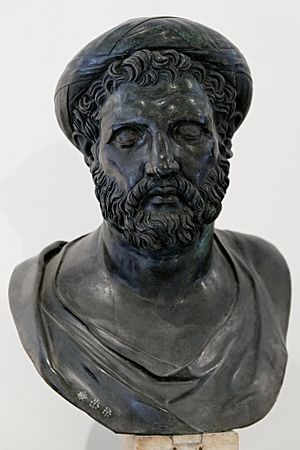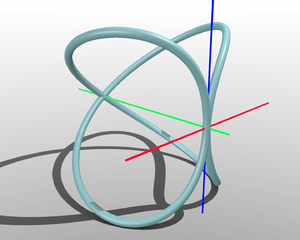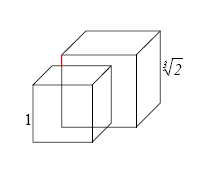Archytas facts for kids
Quick facts for kids
Archytas
|
|
|---|---|

Bust from the Villa of the Papyri in Herculaneum, once identified as Archytas, now thought to be Pythagoras
|
|
| Born | 435 - 410 BC |
| Died | 347 BC (aged 80–81) |
| Era | Pre-Socratic philosophy |
| Region | Western philosophy |
| School | Pythagoreanism |
|
Notable ideas
|
Archytas curve |
|
Influences
|
|
|
Influenced
|
|
Archytas (Greek: Ἀρχύτας; 428–347 BC) was an Ancient Greek thinker. He was a philosopher, mathematician, and astronomer. He also worked as a statesman and strategist. Archytas was part of the Pythagorean school of thought. He is known for starting the field of mathematical mechanics. He was also a good friend of the famous philosopher Plato.
Contents
Archytas' Life and Discoveries
Archytas was born in Tarentum, a Greek city in what is now Italy. His father was Mnesagoras or Histiaeus. He learned from Philolaus and later taught mathematics to Eudoxus of Cnidus. Archytas believed that numbers and arithmetic were the best way to prove things, even more than geometry.
The First Flying Machine?
Many people believe Archytas was the first to combine math with machines. This field is called mechanics. A writer named Aulus Gellius said that Archytas designed a flying device. It was shaped like a bird and moved by itself. It might have used steam to fly about 200 meters! Archytas called this machine The Pigeon. It might have been attached to a wire or pivot to help it fly.
Solving Big Math Problems
Archytas gave the name to the harmonic mean. This is an important idea in math. He also found a way to solve the problem of doubling the cube. This problem asks how to build a new cube that has twice the volume of an original cube. He used a special geometric method to do this.
His ideas about proportions are in Euclid's famous book, Elements. Archytas was one of the first to use moving shapes to study geometry. This helped create the Archytas curve, which is named after him.
A Leader and Friend of Plato
Archytas was a very important leader in Tarentum. He was like Pericles in Athens. The people of Tarentum chose him as their general, or strategos, seven years in a row. This was against their own rules, showing how much they trusted him. He was said to be a great general and never lost a battle.
The Seventh Letter by Plato says that Archytas helped Plato. Plato was having trouble with Dionysius II, a ruler in Syracuse. Many scholars think Archytas might have been a role model for Plato's idea of a "philosopher king". This is a ruler who is also wise and good.
Archytas' Legacy
There is a story that Archytas drowned in a shipwreck. His body was found on the shore. A sailor kindly covered it with sand. This was important because ancient beliefs said a body needed to be buried to rest in peace. However, this story might not be true.
Today, a crater on the Moon is named Archytas to honor him.
The Archytas Curve Explained
The Archytas curve is a special shape. Imagine a cylinder, like a can, and a semicircle. The semicircle is placed on the edge of the cylinder's opening. Then, you rotate the semicircle. As it spins, it cuts a unique curve into the cylinder. This curve is the Archytas curve.
Archytas used this curve to help solve the problem of doubling the cube.
Doubling the Cube: The Delian Problem
One of Archytas' most famous achievements was solving The Delian Problem. This problem asks: if you have a cube, how can you build a new cube that has exactly double the volume?
Archytas' solution used the idea of "mean proportionality." This is about how different parts of shapes relate to each other. His method involved finding certain lengths that would allow him to construct the larger cube. This was a very advanced mathematical solution for his time.
How Sound Works: Harmonic Theory
Archytas also had ideas about music and sound. He thought that the pitch of a sound, like from a string instrument, depended on how fast the sound wave traveled. While we now know pitch is related to frequency, not speed, Archytas' idea was very important. It was one of the first scientific theories about sound.
He also studied musical scales. He showed that basic musical intervals (the distance between two notes) cannot be divided into equal parts using simple numbers.
Thinking About the Universe: Cosmology
Archytas had a famous thought experiment about the size of the universe. He imagined standing at the very edge of the fixed stars. He asked: if he reached out his arm or a stick, would it hit a wall? He said no. He believed he could always reach further, creating more space. This meant that space, for him, was infinite. This idea was very influential, even though other thinkers like Plato and Aristotle didn't fully agree with it.
See also
 In Spanish: Arquitas para niños
In Spanish: Arquitas para niños



